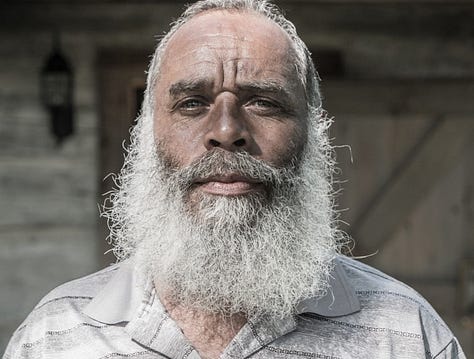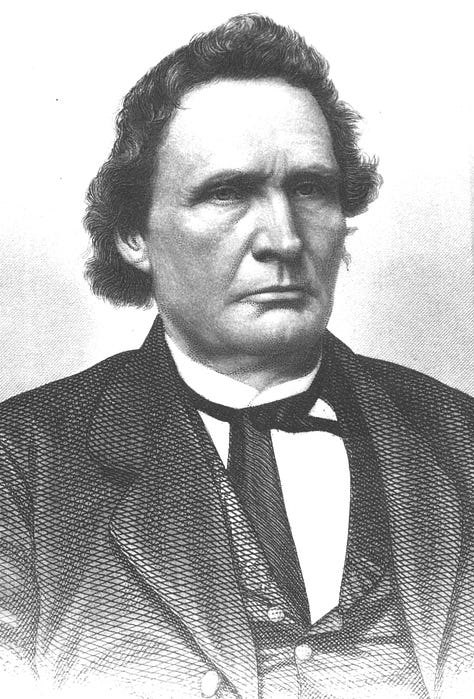Underground Railroad Free Press
News and views on the Underground Railroad • Vol. XX, no. 113, May 2025
Published bimonthly since 2006, we bring together organizations and people interested in the historical and the contemporary Underground Railroad. Free Press is the home of Lynx, the central registry of contemporary Underground Railroad organizations and the Free Press prizes awarded annually for leadership, preservation, and the advancement of knowledge, the community's highest honors. Underground Railroad Free Press is emailed free of charge around the 15th of odd-numbered months. Reach us at http://urrfreepress.com/contact.html.
In This Issue
Tidbits
DOGE Pulls Back
Thaddeus & Lydia
Rescuing a 1729 Safe-house
Earliest African Arrivals. Not 1619.
Photo-exhibit on Canadian Underground Railroad
Canadian reader Jim Drover wants you to know that Art Windsor-Essex, a gallery in Canada, has mounted North Is Freedom, a photo-exhibit covering the history of American freedom seekers making their way to Canada and their descendants today. Shown here are Arlene Duncan, Frank Parker, and an unknown couple from the past. The gallery is located at 401 West Riverside Drive in Windsor, Ontario. Mr. Drover and Free Press publisher Peter Michael were high school classmates. They ran hurdles on the track team. Drover was faster.



Pennsylvania Eco-resort was on the Underground Railroad
Reader Vicki Michael reports that River Mountain Inn, located in the Black Valley in south-central Pennsylvania, sits amidst a network of Underground Railroad safe-houses and routes. Local histories principally credit four residents with leading the aid network in this area: Rev. John Fidler, Elias Rouse, Joseph Crawley, and James Graham. Just to the south of the River Mountain property are 13 unmarked graves of formerly enslaved peoples who died traveling the route to freedom.
The inn, which specializes in “glamping” and wellness retreats, is located at 3600 Black Valley Road, Everett, Pennsylvania.
Chicago to Detroit Freedom Trail
The recently formed Midwest Underground Railroad Network has been incorporated as a nonprofit organization, received its IRS tax-deductible status, and has begun planning for the memorializing of the well-travelled Underground Railroad route from Chicago to Detroit. It was there that freedom seekers were able to cross the Detroit River to Windsor, Canada, and safety. Network members now include leaders in Bronzeville and South Bend, Indiana. Recently, the University of Chicago, Governors State University, Purdue University, and Indiana University have been included in the project. Colleagues in the South Bend region have a Freedom Trail working group on heritage tours in the “Michiana” region. For further information, contact Tomshepherd2001@yahoo.com.
Network to Freedom Website Restored but Damage Elsewhere
On March 18, we published a special edition of Free Press covering the story of the federal government’s intention through President Trump’s executive order, “Continuing the Reduction of the Federal Bureaucracy,” to gut federally-supported cultural programs and how this threatened the Underground Railroad Education Center of Albany, New York, one of the nation’s most esteemed Underground Railroad organizations.
We wrote that, “It would appear that all three of the federal Underground Railroad programs are threatened including the National Park Service’s Network to Freedom program. If these programs disappear, it will be up to the private sector to step up to preserve the irreplaceable Underground Railroad work that the federal government has accomplished.”
Then it happened: By April 6, the administration had rewritten the website of the National Park Service’s Network to Freedom program, removing the picture of Harriet Tubman, references to slavery, and supposedly “divisive narratives.” Statements on the historic struggle of Black Americans for their rights were cut or softened, as were references to present-day echoes of racial division.
While they were at it, DOGE ransacked other federal websites. An educational page on Benjamin Franklin, which examined his views on slavery and his ownership of enslaved people, was taken offline last month. Mentions of Thomas Stone, a signer of the Declaration of Independence, owning enslaved people were removed from several pages on the website of the Stone National Historic site in Maryland.
For unknown reasons, the changes to the Underground Railroad website were quickly reversed and the original version restored. There had been a public outcry over the changes but similar disapproval in other cases had been shrugged off when the administration had made major unpopular changes. It is too much to expect that one of the DOGE boys had a stroke of conscience.
In our last issue, we reported on the threat to government grant programs that support both public and private Underground Railroad programs around the country and the precarious position caused by these cutbacks on Albany, New York’s Underground Railroad Education Center (UREC). Then the worst came. Terminated were UREC’s Institute for Museum and Library Services funding of a project director position, a $250,000 National Endowment for the Humanities grant for UREC’s Interpretive Center, and a $3.6 million Environmental Protection Agency grant also for the Interpretive Center.
The last two grants were to support the building of a community center highlighting local history and culture. This center would provide jobs for community residents, transformational educational experiences and more visitors.
The first grant was intended for planning and implementation of a teen program to prepare high school students to seek employment in the museum field. This program would introduce students to job possibilities in the field and to the value of museums to the health, wellbeing and financial sustainability of communities.
These are now all postponed and one of the country’s best managed Underground Railroad organizations is set back years.
Cupid Overcomes Custom
As a signature project, LancasterHistory, the nonprofit historical society of Lancaster County, Pennsylvania, is nearing completion its Thaddeus Stevens & Lydia Hamilton Smith Center for History and Democracy, a new museum being developed by the organization. https://stevensandsmithcenter.org LancasterHistory has currently raised $18.7 million toward the total $24 million campaign, including a $5 million sustainability endowment. Construction of the museum and educational center began in April 2024 and is now nearing completion. https://www.lancasterhistory.org
Thaddeus Stevens was a politician and lawyer who served as a member of the United States House of Representatives from Pennsylvania, and one of the leaders of the Republican Party during the 1860s. A fierce opponent of slavery and discrimination against Black Americans, Stevens sought to secure their rights during Reconstruction, and led the opposition to President Andrew Johnson. As chairman of the House Ways and Means Committee during the Civil War, Stevens played a leading role, focusing attention on defeating the Confederacy, crushing the power of slave owners, ending slavery, and securing equal rights for freedmen.



Ostensibly, Lydia Hamilton Smith was the long-time housekeeper of Thaddeus Stevens. Her father was a Scottish immigrant, her mother the product of a white mother and black father. Using the “one drop rule,” Smith was legally defined as Black in her time. Lydia Hamilton had been born free.
In the 1840s, Smith separated from her husband, moved with her mother and sons to Lancaster, Pennsylvania, and accepted a position as housekeeper to Thaddeus Stevens. Smith continued to keep house for him until his death in 1868. She would accompany him to Washington during his stints in the House.
During her time with Stevens, neighbors considered her as his common-law wife and addressed her as Madame or Mrs. Smith. She was frequently called Mrs. Stevens by those who knew her well. Smith had two sons from her earlier marriage whom Stevens helped to raise along with Stevens's two adopted nephews. Whether or not the couple may have had a romantic relationship, Thaddeus Stevens, Lydia Smith, and their four sons lived under the same roof as a family. With her $5,000 inheritance from Stevens, Smith purchased the Stevens house and adjoining lot and lived there for the rest of her life. She died in 1884.
The couple used the home as an Underground Railroad safehouse. Recent excavation around their house unearthed a cistern with a passageway to a nearby tavern.
An Exemplary Preservation Project Begun
Reader and eminent Underground Railroad historian Fergus Bordewich tells of a project that he is working on in Claverack, New York, involving the rehabilitation of a modest home that had been used as an Underground Railroad safe-house. Built by the Van Hoesen family in1729, this house - a registered historic site - is one of the oldest and most important examples of residential architecture in the Hudson Valley and one of only a handful of Dutch vernacular houses still in existence.
In the 1800s, the house was owned by Quaker abolitionist Charles Marriott , a fruit grower, who used it as a safe-house. Actually, a freedom seeker was safe once reaching here, only 150 miles from Canada, except from the occasional slave catcher venturing this far north. Today, the home is known as Jan Van Hoesen-Charles Marriott House.
Says Bordewich, “Marriott a close associate with Isaac Hopper in New York City and the Robinson family of Rokeby, in northern Vermont, who with other Quakers formed an Underground Railroad line from New York City to Vermont. Marriot, though barely known even to most historians, was a key figure on the Underground Railroad and left written mention of his assistance to fugitive freedom-seekers in letters to the Robinsons, which are preserved at Rokeby.”
On March 9, Bordewich delivered a presentation on behalf of the African American Archive of Columbia County to a regional audience. He was joined by restoration carpenter and Van Hoesen-Marriott House site manager Ed Klingler. The two told of restoration efforts being planned to refurbish the nearly 300-year-old house. Though historians recognize this house as being one of the oldest and most important examples of residential architecture in the Hudson Valley, decades of neglect have left the house as nearly a desolate ruin.
The African American Archive of Columbia County, New York, documents, preserves, and shares Black history in the upper Hudson Valley. Co-founders Victoria Jimpson-Fludd, her daughter, Lisa Fludd-Smith, and son-in-law, Peter Smith use historical and genealogical research to bring centuries of hidden history to light. Their mission is to forge deeper understanding of the lived experience of the Black residents of Columbia County, from the colonial Dutch era onward, for the benefit of their descendants and the world at large. The Archive sponsors special events and lectures, collaborates with local organizations, and provides genealogy and research assistance to the public.
It was 1526, not 1619
Reader Wayne Young, publisher of Port of Harlem e-magazine, features an article in his current issue that pushes back the arrival of the first Africans to America to 1526 nearly a century earlier that previously believed. Despite the current federal erasing of African American history, the city of Darien, Georgia, unveiled a historic marker on Sunday, April 13, to acknowledge the first recorded arrival in 1526 of a shipment of captive Africans to North America.
This corrects what Free Press had been reporting that the arrival was in 1585 to the Spanish colony at St. Augustine, Florida.
From the article, “The history of captive Africans in Georgia predates by 93 years the 1619 arrival of Africans to the English colony of Virginia. Arriving on the southeastern coast of North America with 600 colonists, approximately 100 enslaved African men were transported with them by Lucas Vasquez de Ayllon to establish the Spanish settlement of San Miguel de Gualdape off the Georgia coast at Sapelo Sound which borders Darien, founded in 1736.
“It failed after two months due to various factors, among them loss of provisions, unseasonably cold weather, illness, death (including Ayllon), dissent among the surviving colonists, and hostilities from the native people and the Africans.
“This alliance between “first” and “forced” (Indigenous and Africans) reflects a pattern of resistance, rebellion, and collaboration against enslavement and loss of freedom that continued over centuries. In the Gullah Geechee Cultural Heritage Corridor, Sapelo Sound is a UNESCO Routes of Enslaved Peoples Project Site of Memory and Heritage and an International Coalition Site of Conscience.”






